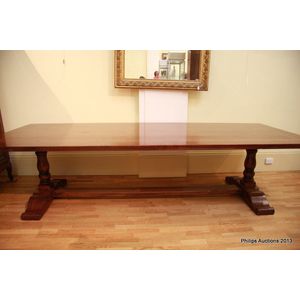Seventeenth-Century Style Fruitwood Dining Table
You must be a subscriber, and be logged in to view price and dealer details.
Subscribe Now to view actual auction price for this item
When you subscribe, you have the option of setting the currency in which to display prices to $Au, $US, $NZ or Stg.
- Stretcher - A horizontal rail which connects the legs of stools, chairs, tables and stands, to provide stabilisation of the legs. A stretcher table is any table with a stretcher base. The term is usually applied to substantial farmhouse tables, although many cabinetmaker's pieces, such as sofa tables, also have turned stretchers.
- Baluster (furniture) - An architectural term for a column in a balustrade or staircase, often defined as a "vase shape". The shape is extensively used in furniture and decorative arts.
In furniture, it is used to describe a chair or table leg turned in that form, or more usually as an inverted baluster, with the bulbous section to the top. Less commonly used to describe a chair back that has the outline of a baluster. A baluster may also be split and applied to the front of a cupboard for ornamentation.
For ceramics and silver items it is often used to describe the shape of the whole item, rather than a part.
In Georgian glassware, the shape is commonly seen in the stem of glasses. - Inlay - Decorative patterns inserted into the main body of a piece of furniture, generally in wood of contrasting colour and grain, though brass, ivory, ebony, shell and sometimes horn have been used. Inlay may consist of a panel of well figured timber inset into a cabinet door front, geometric patterns, or complex and stylized designs of flowers, swags of foliage, fruits and other motifs. As a general rule, in pieces where the carcase is constructed in the solid, the inlay is relatively simple such as stringing, cross banding and herringbone banding. Where more elaborate and decorative work was required veneer was used. Inlay has been fashionable from at least the latter half of the 17th century, when a variety of elaborate forms were developed
- Fruitwood - A catch-all term used to describe the wood of any of several fruit-bearing trees, such as the apple, cherry, or pear, used especially in cabinetmaking.
With a blond colour when finished, fruitwood was used in Europe, especially France, in the 18th and 19th centuries for larger items of furniture such as tables, chairs, cabinets and bookcases but in England its use was generally restricted to decorative elements such as inlays.
This item has been included into following indexes:
- tables, large dining
Visually similar items

A striking French rosewood Art Deco sideboard, circa 1950, a parquetry top above a central cupboard inlaid with mermaids and aquatic motifs, flanked by two double doors covered in cream leatherette opening to beautifully lined and fitted cupboards, upon ly

Vintage stretcher base hall table, 106.5 cm x 50 cm, 75.5 cm high

Edwardian marble top washstand, 105 cm wide, 105 cm high

Victorian cedar side table, 86 cm wide, 77 cm high approx
